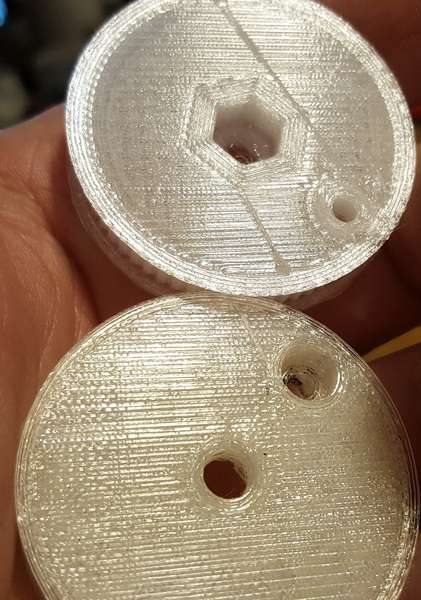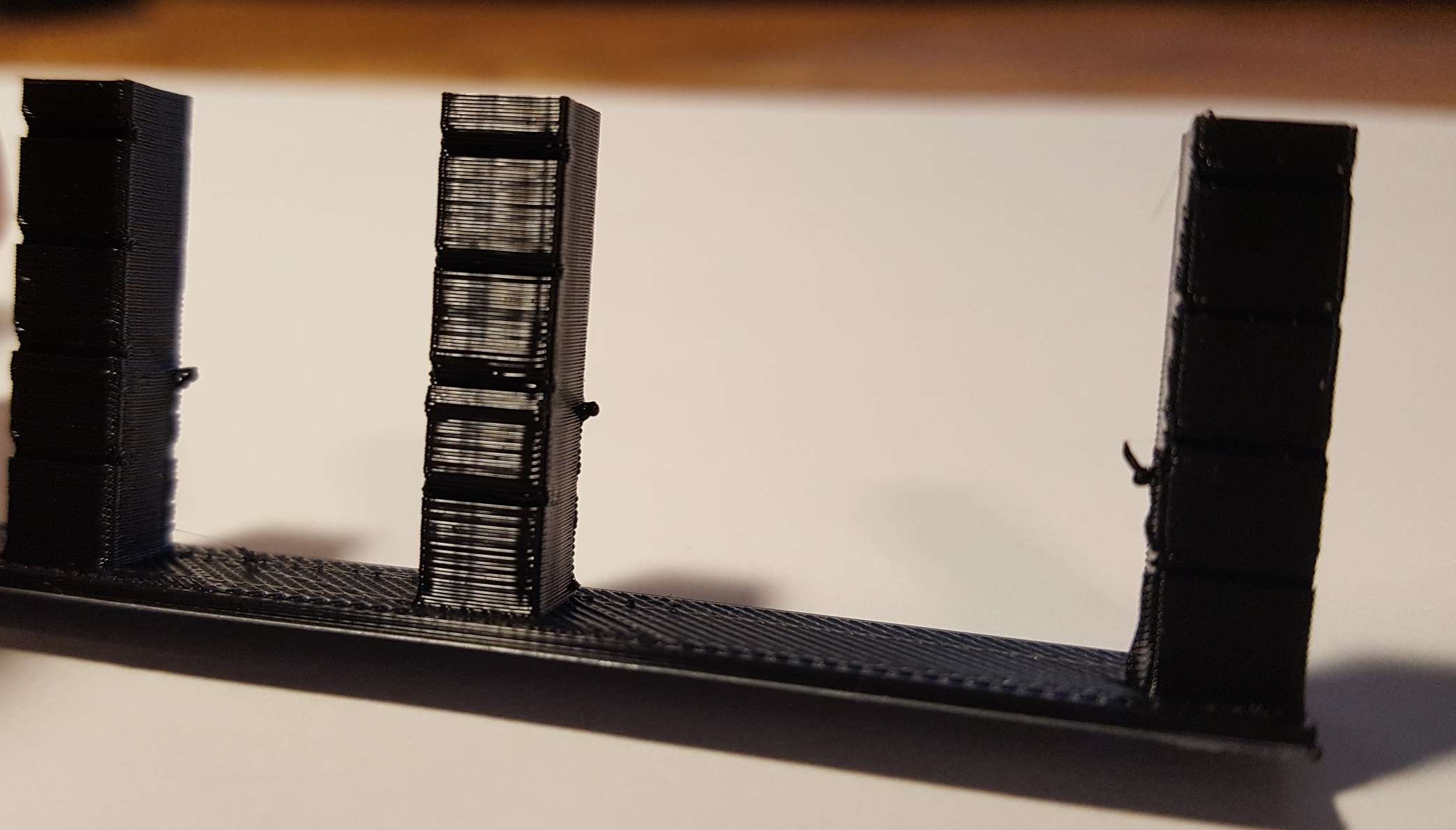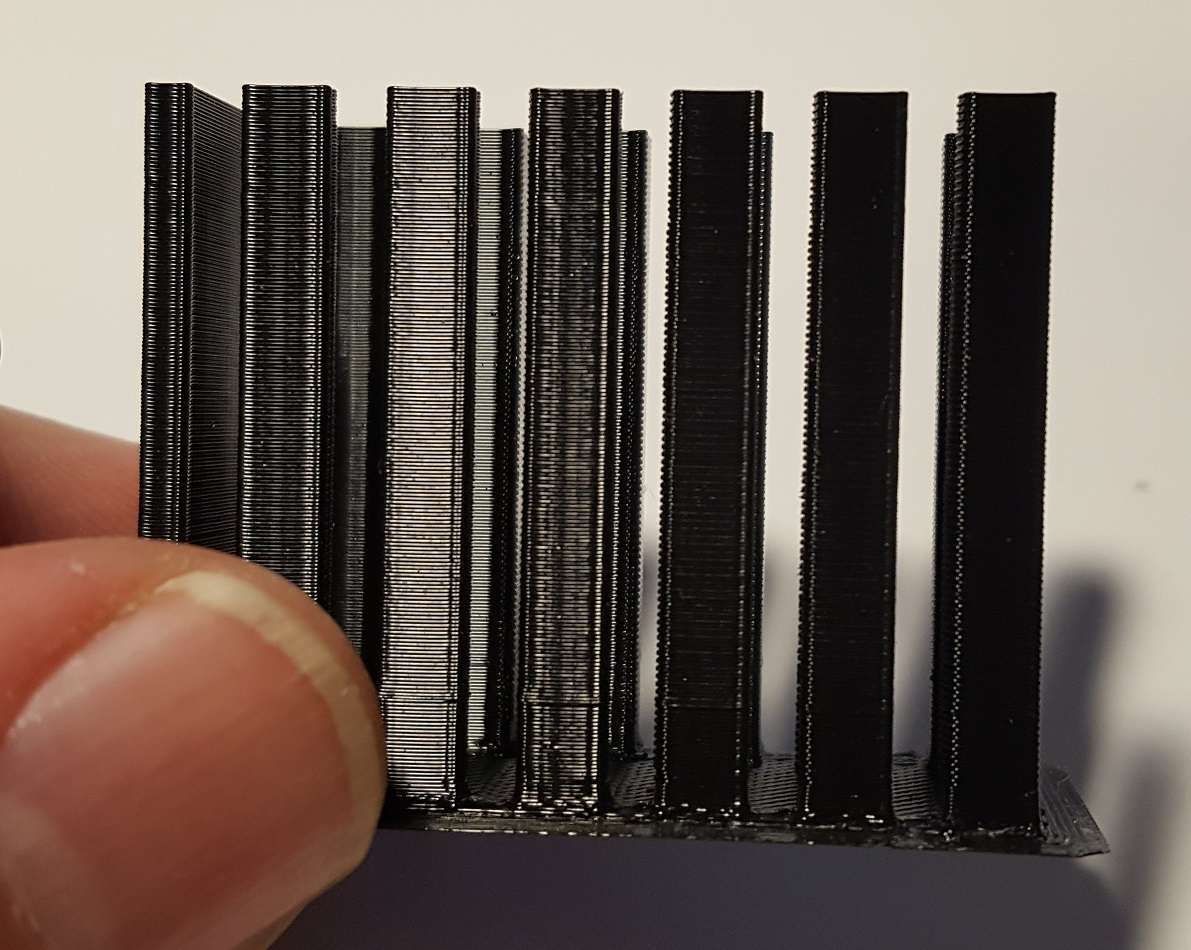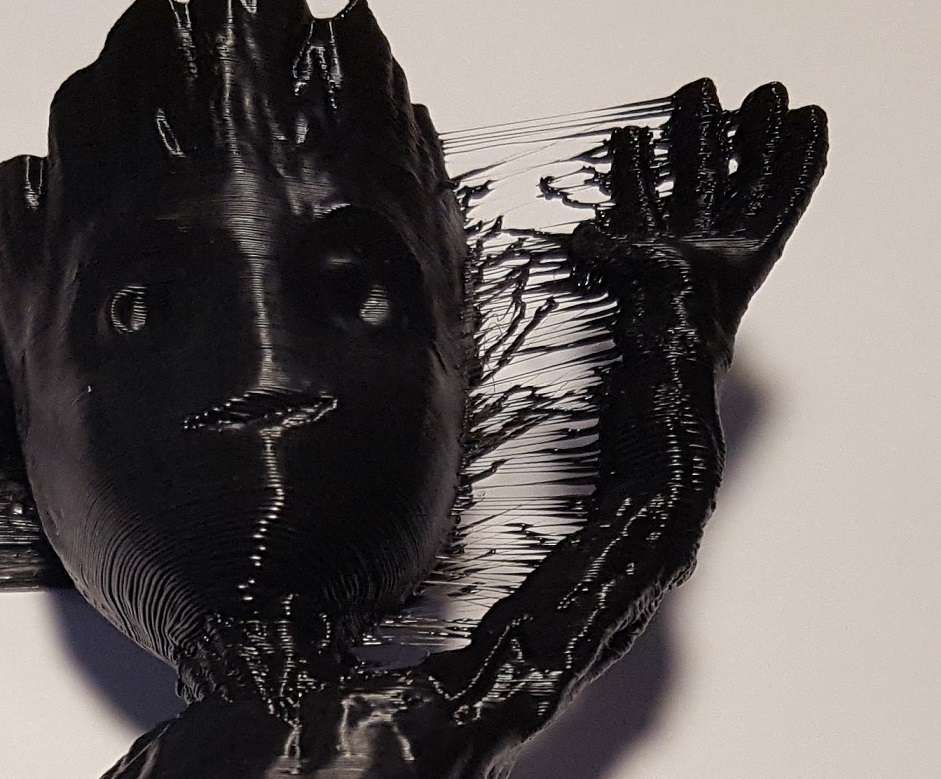Capricorn PTFE Tubing XS- Low Friction
-
Here's an image showing two printed gears (to be used with my belted extruder). The one on top was printed with my extruder stepper set to use 32x microstepping. The one on the bottom had the extruder using 16x microstepping.
If you look carefully you can see the "step pulsing" artifacts are smaller and closer together in the 32x microstepping print as compared to the 16x print.
A geared vs. non-geared extruder should show similar differences due to step pulsing. If anyone's confused, I'm calling it "step pulsing" when the pressure in the extruder system is increased suddenly and then decays a little as plastic flow reduces the pressure due to the discrete steps nature of the stepper motors we use. The closer together the steps are, the lower the difference will be between the highest and lowest pressure (and hence flowrate) of the system as it prints, as well as the frequency of these pressure pulses. The geared extruders have the same effect, ie: more pulses per mm of printed line, at lower pressure difference per pulse.

-
I'd missed this thread before, but just wanted to add that I switched to Capricorn PTFE for my bowden a few months ago, and it was a drastic improvement. The only issue I've had with it was a cheap spool of filament that jammed… the filament was > 1.78mm in spots. Outside of that bad roll, it's been awesome. I highly recommend i t.
Did you lower all your retraction settings? I found that i needed to lower retraction down quite a lot after the upgrade as i quickly jammed and needed to perform a cold pull with nylon to clear everything.
Yes, I went from 3.5mm retraction and still some fine stringing, to 1.3mm retraction, zero stringing. No other change than the Capricorn bowden tubing, cut to the same length. (E3dv6 & titan combo)
-
Yes i experienced the same result with setting extruder to 32… the layer lines on the side become pretty difficult to see without the right reflection or close up photo at 32
currently back at 16 just until i dial in my top speed then ill try switching back to 32
I plan on testing a 0.9 degree motor for my extruder as well.
you should try printing with Igus Iglidur 180 PF filament... it is expensive but incredibly precise, it can print straight up in the air and 90 degree overhangs without issue.... with this precision comes tell tail signs of extruder issues which has helped me fine tune even further.
That and it makes for some seriously sharp gears and bushings.
I will be doing a review in a new thread soon
-
you should try printing with Igus Iglidur 180 PF filament… it is expensive but incredibly precise, it can print straight up in the air and 90 degree overhangs without issue.... with this precision comes tell tail signs of extruder issues which has helped me fine tune even further.
I agree, the 180 filament prints really well. I've tried it and the 170. Now they've come out with the 260 and something else, I think 210. I'm going to get a sample of the 260 and try it out. It's supposed to be better than the 170 in terms of friction and wear.
If you like the Igus filament, if you have a D-bot you should check out my Igus filament bearing pads on Thingiverse. Basically I replaced all 12 mini V-slot wheels that ride in the V-slot grooves of the D-bot's X/Y motion system with carrier blocks that fit in the same space as the wheels did, and have Igus filament pads that actually ride on and in the grooves of the v-slot. This allows a much tighter installation with zero or at least undetectable by hand slop in the fit and alignment of the X gantry and the print carriage. I'm really pleased with it so far. I've been printing entirely without wheels on my X/Y for about 6 or 7 weeks now. I'm currently working on a solution to replace the wheels on the Z axis with Igus pads as well.
https://www.thingiverse.com/thing:2373538
I've tried the 180 and 170 filament with these pads. The 180 printed easier, but I believe the 170 had less friction and is supposed to wear better. I'd really like to try out the 260 filament.
-
Yeah getting a roll of 260 to compare was on my list, they say its the equivilent of their injection molded parts but we'll see… i actually prefer the 180 over the preloaded igus bearings. When i printed the lm8uu style bearings in 180 i printed them tight and slowly reamed them out with a 8mm drill bit just until they would slowly slide up and down while i flipped the x shaft end for end.
Then i took the bearing with my hand and moved it fast up and down.... the slight friction actually is a friend of the 180.... once they are warmed i again tipped it end for end and the speed in which these light bearings move is easily double that of the preloaded igus bearings which weigh a lot more because of their aluminum housing. All while maintaining tight tolerences compared to the sloppy igus bearings.
When warmed the bearing actually acts like its running on an air hockey table.
I have hopes that the 260 will be similar but with better strength but its up there with 170 in regards to printability.
I wish they had more data on their website comparing the differences.
That is awesome about printing without wheels.... I printed every moving part with 180 yesterday.... just have to get it all installed now. So far just my X carriage is using 180 bearings
If you know where to buy 260 in the US please let me know... I can only find 180 and 170
-
Call this lady:
Cindy Mowry
Igus Inc.
East Providence, RI
Phone: 800-521-2747
Fax: 401-438-7270
cmowry@igus.comThe j260 filament shows up as $64/250g here:
http://www.igus.com/wpck/14928/N15_04_14_iglidur_J260The i170 has the same 250g rolls for about the same price, but they also have a 750g roll for like $94. I was going to order a 750g roll of 170 until I found out about the 260. Now I want to try it before pulling the trigger on the 170. So far I've been using samples from Igus. They'll send a sample out to anyone, but they sent me more than one sample of both the 170 and 180 because I told them I was developing some solutions with them that I intended for general release.
Btw, what printer are you using? You just said you printed every moving part yesterday with 180. Every moving part for which printer? A D-bot? If so, I'd be curious what you think of the X/Y motion bearing pads for the D-bot that I linked to in my previous post.
-
I've seen quite a few posts where people were building D-bots and then buying expensive Hiwin linear guide rails and bolting them onto the v-slot. I thought that's just ridiculous. Part of the beauty of the D-bot is in the way the rails that make up its frame perform double duty as the linear guide rails for the X/Y/Z motion system. That's very simple and elegant. The only problem is that a lot of people just aren't happy with the performance of the mini v-slot wheels, and find the Hiwin rails give them better precision, less play and slop, low friction, etc.
I believe my Igus sliding bearing pad solution that uses the v-slot rails instead of additional bolt-on rails is cheaper than going with Hiwin, while achieving all of the same advantages of the Hiwin guide rails over the v-slot wheels. And best of all, it's an almost invisible mod that people might not even notice, because it doesn't involve bolting all kidns of extra hardware onto the v-slot. The parts I've designed blend in very well with the original D-bot parts they are used with.
I've modded my D-bot quite a bit over stock, and yet it doesn't immediatey look to the casual glance like it's heavily modded because I've tried to maintain the simplicity of the design without bolting all sorts of extra crap onto it. I'm about to publish a v2.0 of my Igus bearing pad D-bot X/Y system with more refined carrier blocks that blend in better with the stock D-bot parts they mate up with (there's also a moderate improvement in the Igus sliding pad itself in this v2.0). That will probably go up tonight.
-
i heavily modified a XYZ Davinci Pro…. your linear rail solution has me interested for another build. I will take a closer look tomorrow.
Thanks for the igus contact info
-
I got my Capricorn tubing yesterday and put one in (using one side of the Chimera for now). It does seem noticeably better.
Right now I'm having some trouble understanding a stringing/oozing problem I'm having.
With the Capricorn tubing I ran some test prints where I reduced the retraction from the 4.6 I'd been using with my cheapo PTFE tubing in steps all the way down to 2.0, and in some tests, 1.5. With conventional retraction tower tests I saw great results. I've got two retraction tests I'll show in a few minutes that went down to 2.0mm retraction that show zero stringing.
Then I printed off a 90-100mm tall Baby Groot and there's just god-awful stringing between his legs, and between his arms and his body. After a 2.0mm retraction Groot showed signs of bad stringing I bumped it to 2.5mm and reprinted, and it's still bad. I'm running one right now at retraction of 3.0mm and I'll see soon enough whether that's going to do it.
After the retraction tower tests I was feeling pretty awesome about the possibility of having my retraction down to nearly approaching direct extruder levels, but after these Groot tests I see that's not realistic.
I'm a little confused though as to why my retraction tower tests are coming up perfectly stringing/oozing free at 2.0mm, but these Baby Groot's are coming out with awful stringing.
I thought I understood retraction pretty darn well, and so this has me nervous, because I know I'm missing something that would explain this.
I'll put some photos in just a minute.
-
As the filament passes through the extruder, it get squashed a bit into an oval, or the hobbed bolt bites into it leaving tiny ridges. It doesn't take much of a deformation for the filament to then stick inside the tube. So one possibility for variable retraction with 1.8mm ID tubing is that with short moves followed by retraction, the same piece of filament goes back and forth inside the extruder and gets squashed more than once, leading to extra deformation or hobbed bolt ridges getting bigger, making the filament more likely to stick in the tube (compared to long moves between retraction) causing the extruder to skip slightly.
-
Ok here are photos show two different retraction towers and a Baby Groot. The two towers show little/no stringing all the way down to 2.0mm retraction (tiny little nubs of stringing on the widely-spaced towers at 2.0 and 2.5). The Baby Groot was printed at 2.5mm retraction and as stringy as hell.
I'm trying to figure out what I'm missing. The other settings are the same. I've tried obvious things like dropping print temperature. I've tried from 210 C all the way down to this Baby Groot at 190 C, and it hasn't helped.
One hint I have is in this one photo of a retraction tower where there's a little crap thing sticking out about 1/4 of the way up. That's where the process I used there happened to have accidentally some "bottom" layers set up. I suspect it has something to do with the retraction towers being fairly low print density with single or double walls, while the Baby Groots had more infill and hence more printing occurrred between moves. Still not sure why such short retraction works fine on the retraction towers but not well with the real print.



-
Is the printing speed of the towers a lot slower than the speed of the baby groot?
-
The towers and the Groot were both set to 60mm/s, but what the actual speed was would be impossible to say, since both have sections small enough that acceleration settings would slow things down somewhat. The arm that you see in the Groot photo is approximately the same diameter as the retraction towers, so we might assume that the nozzle reached similar speeds going around that arm as it did on the towers, though the towers have 90 degree corners and the arm doesn't.
I just ran some more towers where I went from 2 to 3 perimeters to see if the difference was simply down to how much actual printing got done between retractions (see if maybe on the towers the extruder/bowden/nozzle system hadn't reached its normal steady state pressure due to how little was printed between retractions and repriming). At 2.0mm retraction I got enough oozing to create the usual "hangers" sticking off the side of the tower at an angle. At 2.5mm there were little nubbins sticking out, and at 3.0 there were nearly but not quite nonexistent nubbins, and at 3.5mm retraction no sign of any oozing whatsoever.
I've got to go somewhere for a while, so I just started a Baby Groot with retraction set to 3.1mm. I'll see how it went when I get back.
If it works great, and continues to work for other types of prints with larger pieces, sharper corners, wider spaces, etc., then I'll know that for at least this filament the new retraction of 3.1mm is it. This is compared to 4.6mm with my previous cheapo PTFE.
While I was hoping to get it all the way down to 2mm, and thought I had with my original retraction tests, I'll say that 3.1mm from 4.6mm is a huge improvement. It means that the pressure "spring" inside the tubing from the filament kinking up and absorbing or releasing incoming filament feed rates is substantially reduced by using this tubing with its smaller diameter.
This filament (Hatchbox black PLA) measures out at only 1.72 to 1.73mm, unfortunately. If reducing the diameter of the PTFE tube is mostly responsible for reducing the bowden tube pressure spring, then it's probably also true that the closer in diameter you get from the filament to the ID of the PTFE tube, the better. I'd be better off with filament measuring 1.76 or 1.77 than 1.73.
Sounds like a small difference, but the bowden tube pressure spring effect is responsible for keeping filament flowing more than you want going into corners where the deceleration of the nozzle requires slowing down the filament flowrate to avoid blobbing, and not accelerating as fast it should coming out of corners (which results in thinning of the part coming out of the corners). If a difference of only .15mm inside diameter of the bowden tube can drop my retraction from 4.6 to 3.1mm, then .03mm difference in filament diameter is a bigger deal than you'd think.
Most of my filaments measure out at 1.75 or 1.76 or so. I'll have to figure out what filaments tend larger and buy more of that, and less of the stuff that measures smaller. I'm disappointed that this Hatchbox PLA measured out smaller like this. My Hatchbox PETG typically comes in at least 1.75mm.
-
I get mixed results based on filament. Some filaments i am running as low as 1.25mm with a 400mm tube.
-
I should add that i have not compared different brands of the same type of filament and also pressure advance can have some effects on what you are seeing, try playing with it on the fly when printing grub… it also plays differently based on filament. Also do you use a retainer clip on the collet where the ptfe enters your hotend... i have found this to improve results as well (several designs sare available on thingiverse)
-
I had pressure advance on with S0.12 and was doing a test print with retraction at 3.1mm and getting stringing and oozing. I turned off the pressure advance on the fly and the stringing just stopped.
Went back and tried more lower retraction settings and in the upper 2s it was greatly reduced, but not eliminated or all but eliminated until 3.1mm. This is on that baby Groot. I'm doing a different print now with different infill and perimeters and whatnot, no pressure advance, with 3.1mm retraction. Haven't gotten to the point yet where I'd expect stringing if it was going to happen. I'll know in the morning.
I'm betting that whatever stringing or oozing I get will in fact be very dependent on the specific filament, with the thicker filaments behaving better than the narrow ones like this 1.73. I've got a roll of cheap Chinese filament that's only 1.68 and it's just crap because it flexes too much.
I've got this spool of ASA I've been experimenting with that's a little thicker. I don't recall but it may have been 1.77mm or so. I'm anxious to give it a try.
Until this Capricorn tube I'd had to use 4.6mm as my general retraction setting. Even if I've only gone from 4.6mm to 3.1mm that's a substantial reduction, given that every mm of retraction represents a milimeter of spring-like compression in the tube that's going to blob or underextrude my accelerations and decelerations.
This has me thinking about the rest of my system. There are some spots at the extruder and going into the tube retainer that's screwed into the extruder where the filament isn't well constrained and can bend and flex a little. I'll see what I have to do to provide some contraint to the filament in these areas. It may be good for another little drop in retraction.
And no, I don't actually have a retaining clip under the tube entry on the print head. The carriage plate I printed up blocks it. I've been thinking about remixing it to add a little hole where I can slide in a retaining clip with a pair of tweezers or something. I've got a retaining clip at the extruder end.
So far for $10 or whatever it was I think the Capricorn tube is worth it.
-
I think somebody is making a good deal of money with this product.
I wonder if if can be purchased in bulk.
Still I would like to try it.
Frederick
-
It can be purchased in bulk, filastruder cuts to length ordered. It is pure raw ptfe and tight torrence production processes but yeah still overpriced but the results i have seen make it a necessary upgrade to any bowden system.
-
For a Rostock Max sized build with a Bondtech Extruder and the Capricon XS my settings for Simplify3D are copied below for reference. They seem to work pretty well with PLA. I have not had any jamming issues so far.
I reduced my retraction length by about 25% after installing the Capricorn tubing. I would guess at 25% - 50% reduction in your previous retraction distance should work pretty well.
[c]Retraction: 5.00mm
Extra Restart Distance: -0.50mm
Retraction Vertical Lift = 0.15mm
Retraction Speed: 100mm/s
Coasting Distance: 1.50mm
Wipe Distance: 2.00mm[/c] -
The towers and the Groot were both set to 60mm/s, but what the actual speed was would be impossible to say, since both have sections small enough that acceleration settings would slow things down somewhat. The arm that you see in the Groot photo is approximately the same diameter as the retraction towers, so we might assume that the nozzle reached similar speeds going around that arm as it did on the towers, though the towers have 90 degree corners and the arm doesn't.
I just ran some more towers where I went from 2 to 3 perimeters to see if the difference was simply down to how much actual printing got done between retractions (see if maybe on the towers the extruder/bowden/nozzle system hadn't reached its normal steady state pressure due to how little was printed between retractions and repriming). At 2.0mm retraction I got enough oozing to create the usual "hangers" sticking off the side of the tower at an angle. At 2.5mm there were little nubbins sticking out, and at 3.0 there were nearly but not quite nonexistent nubbins, and at 3.5mm retraction no sign of any oozing whatsoever.
I've got to go somewhere for a while, so I just started a Baby Groot with retraction set to 3.1mm. I'll see how it went when I get back.
If it works great, and continues to work for other types of prints with larger pieces, sharper corners, wider spaces, etc., then I'll know that for at least this filament the new retraction of 3.1mm is it. This is compared to 4.6mm with my previous cheapo PTFE.
While I was hoping to get it all the way down to 2mm, and thought I had with my original retraction tests, I'll say that 3.1mm from 4.6mm is a huge improvement. It means that the pressure "spring" inside the tubing from the filament kinking up and absorbing or releasing incoming filament feed rates is substantially reduced by using this tubing with its smaller diameter.
This filament (Hatchbox black PLA) measures out at only 1.72 to 1.73mm, unfortunately. If reducing the diameter of the PTFE tube is mostly responsible for reducing the bowden tube pressure spring, then it's probably also true that the closer in diameter you get from the filament to the ID of the PTFE tube, the better. I'd be better off with filament measuring 1.76 or 1.77 than 1.73.
Sounds like a small difference, but the bowden tube pressure spring effect is responsible for keeping filament flowing more than you want going into corners where the deceleration of the nozzle requires slowing down the filament flowrate to avoid blobbing, and not accelerating as fast it should coming out of corners (which results in thinning of the part coming out of the corners). If a difference of only .15mm inside diameter of the bowden tube can drop my retraction from 4.6 to 3.1mm, then .03mm difference in filament diameter is a bigger deal than you'd think.
Most of my filaments measure out at 1.75 or 1.76 or so. I'll have to figure out what filaments tend larger and buy more of that, and less of the stuff that measures smaller. I'm disappointed that this Hatchbox PLA measured out smaller like this. My Hatchbox PETG typically comes in at least 1.75mm.
Did this work on the groot?